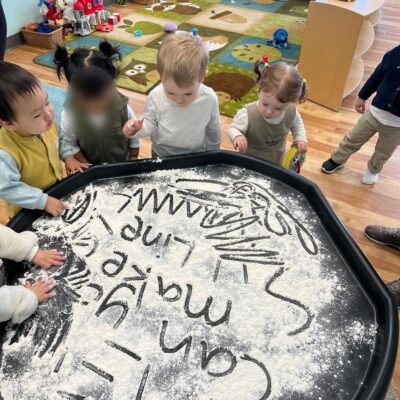As a parent, you want your child to master the art of writing as soon as they can hold objects with their fingers. However, writing often doesn’t come easy, and children may require long periods of practice before they become proficient. Including tracing in your child’s early learning activities can help them sharpen their pre-writing abilities and build a solid basis for both drawing and writing. In this article, we explore tracing techniques to teach young learners.
1. Engage children in activities that involve arm movement
Before introducing your child to letter and number tracing, begin with activities that require large arm movements. Writing is all about learning to control arms and fingers. Participating in activities involving arm movements helps strengthen arms and refine finger movements.
2. Develop their pincer grip
The pincer grip is the coordination of the index finger and the thumb to hold something. This skill typically develops in babies between the ages of 9 and 10 months. The pincer grisp is a significant fine motor achievement that helps them hold pencils and other writing instruments. Numerous activities help lay the groundwork for this skill, including:
- Turning pages of a book
- Using tweezers, spoons or forks
- Eating with hands and playing with toys of different sizes
3. Teach them to trace basic shapes
Drawing shapes in the air with the pointer finger is one way to help your child learn how to trace shapes. Children also enjoy touching and exploring different textures. Filling a pan halfway with shaving cream, flour, or sand and allowing your child to trace shapes of different sizes with their finger is also a good foundation for tracing.
4. Show them how to trace toys, hands and alphabet letters
Toys, hands and alphabet letters come in various shapes and sizes. Children can trace around their hands and toys and follow dotted lines in an alphabet worksheet as they learn about structure. Eventually, they’ll be able to draw these shapes unaided.
5. Teach them to recognize and trace names
One of the early literacy skills that children learn is to recognize names. Knowing one’s own name helps children feel important, and knowing others’ names helps them build a community. A great way to start teaching your child how to write is by showing them how to write their name properly. Learning how to recognize and trace their names enables children to better understand letters and sounds and how they interact.
You can help your child learn to recognize and write their name by:
- Creating tracing patterns: Use dotted lines on paper that spell out the letters in your child’s name. This will help them learn how to form these letters and improve their motor skills.
- Displaying their names on labels or posters: Seeing their name on their lunch box or in their bedroom will improve your child’s memory and make tracing easier.
- Experimenting with different materials: Tracing names doesn’t have to be done using pen and paper. You can make the activity fun for your child using different materials like clay, pebbles and paint.
Early learning at Rothewood Academy
At Rothewood Academy Early Learning centres our early learning educators are dedicated to providing the best tracing techniques to help your child refine their pre-writing skills and build the foundation for drawing and writing letters and words.
Contact us today to learn more about our programs or schedule a tour of one of our schools.

